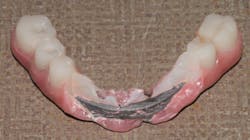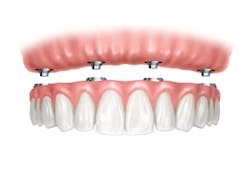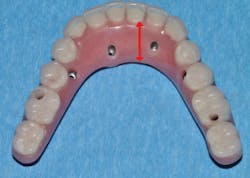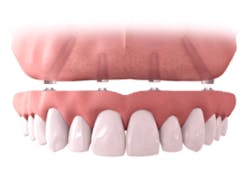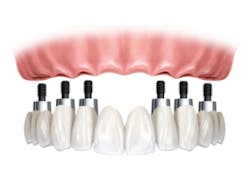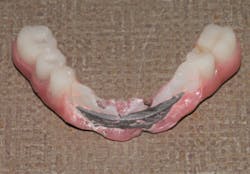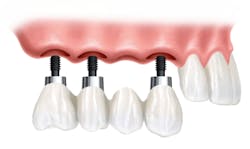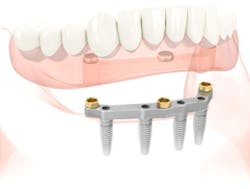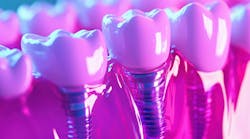When is All-on-4 the best option? 5 factors to consider when creating your dental treatment plan
Originally posted in 2017 and updated regularly
Dental implant treatment has guidelines, not rules. It’s one of the reasons why I love dental implants so much. Every case is different. The clinician must have a broad understanding of each patient's unique factors, and then devise the best treatment plan for that individual. Even the most routine-appearing implant case can be impacted by factors such as parafunction, occlusion, periodontal disease, the size of the space to be restored, and the patient’s budget.
It is important for clinicians to assess these factors and listen to their patients' wants prior to offering treatment plans. Although these factors must be considered for fully edentulous patients as well, for purposes of this article I will address cases only for patients who have most of their teeth and who are considering removing them for implant treatment.
Full-arch fixed implant bridges—often referred to as All-on-4 (figure 1)—are taking the dental field by storm. These bridges are usually supported by four to six dental implants, which are fabricated from materials such as acrylic fused to titanium, monolithic zirconia, and porcelain stacked to a cobalt-chromium frame. They are often presented with package pricing, which simplifies case presentation, and some practices promote All-on-4 as the best treatment option for their soon-to-be-edentulous patients.
Thanks to aggressive marketing by companies such as ClearChoice and the extensive information available on the internet, patients are more aware than ever of the benefits of All-on-4 bridges. Five to 10 years ago, most patients were unaware that All-on-4 bridges existed. Today, it is common for patients to specifically request this treatment, but is it always in their best interests? As wonderful as All-on-4 bridges are, when are they a disservice?
More about implants ... What implant is this? How to identify dental implants
It would take a very long article, or more likely a book, to cover everything we should consider when recommending All-on-4 treatment, but these are the five factors that I encounter on a regular basis in my dental implant practice:
- Speech issues
- Difficulty adapting to bridge thickness
- Proprioception
- Parafunction
- High caries index
Let's take a closer look at each of these aspects and, one by one, see how each might affect treatment considerations.
Speech issues
(figure 3).1 Likewise, horizontal bulk in the posterior can affect the "S" sound, where the lateral borders of the tongue flare upon making the sound. This can result in slurring.2
All-on-4 patients need to be made aware of this compromise. They can often retrain their tongues with time and practice, but it is likely to be a significant source of anxiety for them. If speech is a major concern, clinicians must be prepared to offer alternative treatments, such as a plan that saves healthier teeth and replaces missing teeth with short-span bridges or individual dental implants. If the teeth are terminal, a bridge that only replaces missing tooth structure can be an option. However, this will often require more implants, more bone grafting, and more expensive prosthetics, so patients will need to be prepared for the additional treatment time and cost.
Difficulty adapting to bridge bulk
patients an All-on-4 model and then a model of a traditional bridge (they’ll get the idea even if it’s tooth-borne) (figures 4 and 5). If the bulk will be an issue, then they should consider options that only replace tooth volume. Due to the reduced bulk of these restorations, both vertically and horizontally, more implants likely will be required to support the bridge to reduce pontic spans and the risk of fracture. Distal cantilevers may need to be shortened and the implants placed more posteriorly, which could result in the need for grafting. Patients may choose the traditional All-on-4 bridge after consultation due to lower cost and reduced treatment time. In any case, patients are more likely to accept any compromises when they have options to choose from and know about any limitations prior to treatment.
Proprioception
With teeth, feedback from PMRs assists with refined motor movements, so chewing efficiency is improved. With dual-arch implants, less refined movements result in poorer chewing efficiency and greater stress on the restoration and implants due to angled forces.7
My dual-arch All-on-4 patients experience more lost implants during healing, broken temporaries, and tooth popping. Always consider restorative options that save at least a few teeth if both arches are undergoing treatment. If this isn't possible, consider staging treatment by treating the upper arch first while opposing natural teeth for the first few months. You may need to modify the teeth to level the occlusal plane. The proprioception of the lower teeth will assist patients in avoiding excessive biting force and learning to recognize occlusal discrepancies. After a few months, you can treat the lower arch. This will give patients time to develop mechanoreceptors in the orofacial tissues—such as muscles, joints, and periosteum—to assist with feedback.8 Maxillary implants will also benefit from the extra healing time to increase osseointegration prior tobeing subjected to the traumatic forces of the opposing implant-supported bridge.
Parafunction
Parafunctional habits—such as bruxism, clenching, and irregular chewing cycles—may impact your treatment decision. As discussed in the last section, teeth can detect forces much more readily than implants.9 Including a few saved natural teeth in your treatment plan may enable patients to sense the parafunction better (figure 7), which will increase the chances of them modifying the negative behavior.
If it is necessary to replace all of the teeth when parafunction is present, you may want to consider recommending a bar-supported overdenture (figure 8).
This is still technically an All-on-4 procedure, but it may be a modification from your patients' visions of fixed bridges. I use bar overdentures for patients who brux aggressively. The overdenture can be removed at night and replaced with a flat-planed night guard that snaps onto the bar for retention. This protects the final prosthesis and reduces strain on the supporting implants and bone.
High caries index
It’s an all-too-common scenario: A patient presents with an upper full denture—maybe even an upper All-on-4—and decayed and missing lower teeth. The patient wants a lower All-on-4 fixed bridge. He has a square-shaped jaw, likes to eat steak, and you suspect he’s a bruxer. Teeth Nos. 18, 19, and 30 are fractured to the gumline, having had previous root canals and crowns. Tooth No. 31 has furcation involvement and is mobile. Teeth Nos. 23 through 26 are covered with calculus and have 7 mm pockets, but teeth Nos. 20 through 22 and Nos. 27 through 29 have minimal bone loss and mobility. Should you save the teeth? What are the risks and benefits?
These are my thoughts: If the bicuspids and canines have minimal mobility and are mostly intact (perhaps one needs a crown and one needs a filling), then I would consider saving them. The risk of developing further periodontal disease or failure from decay is likely less than the risk of fracturing the prosthesis or damaging the implant/bone complex due to overly aggressive chewing or parafunction.
Now, let’s consider the same scenario, except five of the six bicuspids and canines have Class V decay, four have interproximal decay, and the teeth are covered in plaque. The cavities aren’t that big—you can fix them—but how are you feeling about the future prognosis? I’m an optimist, but my optimism has gotten me into trouble in cases such as these. It’s difficult to change a habit. And in this scenario, we are asking the patient to improve his home care, visit the dentist more frequently, and significantly reduce his sugar intake. That’s a lot to ask. The risk of losing these teeth to decay in the not-too-distant future likely exceeds the risk of prosthesis fracture or bone loss. Maybe the best treatment for this patient is an All-on-4 bar overdenture. Aside from the ability to lessen stress, this treatment will accommodate a simplified oral hygiene protocol. You will want to invest plenty of time with this patient prior to the final treatment decision.
Conclusion
We are blessed to have these implant technologies in our armamentarium as options to replace missing teeth. In the past, patients seemed happy just to be able to chew again. They were so appreciative. I used to say that I loved treating full-arch cases, because I was addicted to the hugs. Today I still get hugs, but not nearly as often. Expectations have risen. Patients seem less tolerant of the awkward feel of All-on-4 bridges and of the amount of time the procedure takes. As they become even more educated about their options, I suspect this trend will continue.
This is what I recommend: Offer multiple full-arch restorative options in your practice, but take time to assess the best individual options for your patients. Make sure you educate them about the hurdles they will need to overcome, not just the benefits of the treatment. It is time well spent. You’ll have better treatment outcomes and more satisfied patients. And isn't that what we really want?
References
- Chierici G, Lawson L. Clinical speech considerations in prosthodontics: perspectives of the prosthodontist and speech pathologist. J Prosthet Dent. 1973;29(1):29-39.
- Pound E. Let /S/ be your guide. J Prosthet Dent. 1977;38(5):482-489.
- Farahani RM, Simonian M, Hunter N. Blueprint of an ancestral neurosensory organ revealed in glial networks in human dental pulp. J Comp Neurol. 2011;519(16):3306-3326. doi: 10.1002/cne.22701.
- Klineberg IJ, Trulsson M, Murray GM. Occlusion on implants—is there a problem? J Oral Rehabil. 2012;39(7):522-537. doi: 10.1111/j.1365-2842.2012.02305.x.
- Yoshida K. Tactile threshold for static and dynamic loads in tissue surrounding osseointegrated implants. In: Jacobs R, ed. Proceedings of theOsseoperception. Leuven, Belgium: Catholic University of Leuven; 1998:143-156.
- Trulsson M, Johansson RS. Forces applied by the incisors and roles of periodontal afferents during food-holding and -biting tasks. Exp Brain Res. 1996;107(3):486-496.
- Svensson KG, Grigoriadis J, Trulsson M. Alterations in intraoral manipulation and splitting of food by subjects with tooth- or implant-supported fixed prostheses. Clin Oral Implants Res. 2013;24(5):549-555. doi: 10.1111/j.1600-0501.2011.02418.x.
- Klineberg I, Calford MB, Dreher B, et al. A consensus statement on osseoperception. Clin Exp Pharmacol Physiol. 2005;32(1-2):145-146.
- Hämmerle CH, Wagner D, Brägger U, et al. Threshold of tactile sensitivity perceived with dental endosseous implants and natural teeth. Clin Oral Implants Res. 1995;6(2):83-90.
About the Author

John A. Hodges, DDS, FICOI
John A. Hodges, DDS, FICOI, graduated from the University of Southern California Dental School in 1993. He runs a practice dedicated solely to dental implant services in Covington, Washington. Dr. Hodges lectures nationally for Neoss and Nobel Biocare on subjects including full-arch implant prosthetics, restorative complications, and Locators. He completed the fellowship program at the California Implant Institute, has restored hundreds of fixed full-arch implant restorations, is a Nobel Biocare CAD-certified technician, and is a fellow of the International Congress of Oral Implantologists. Contact him through his website.
